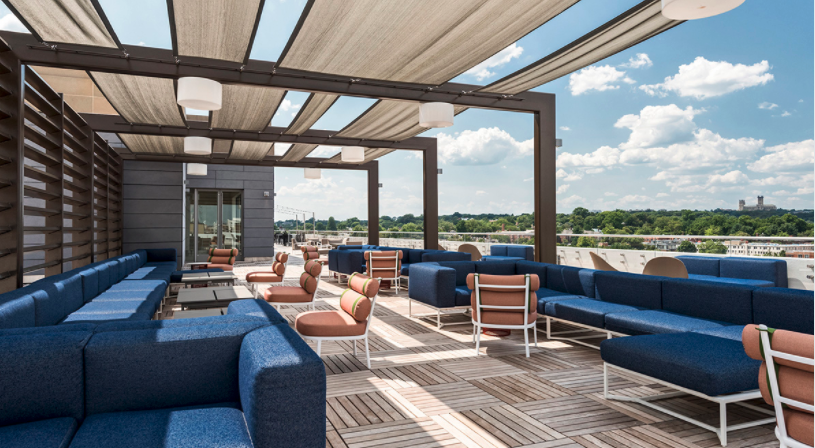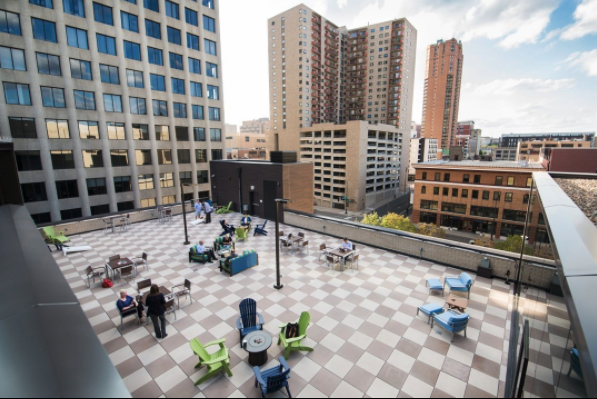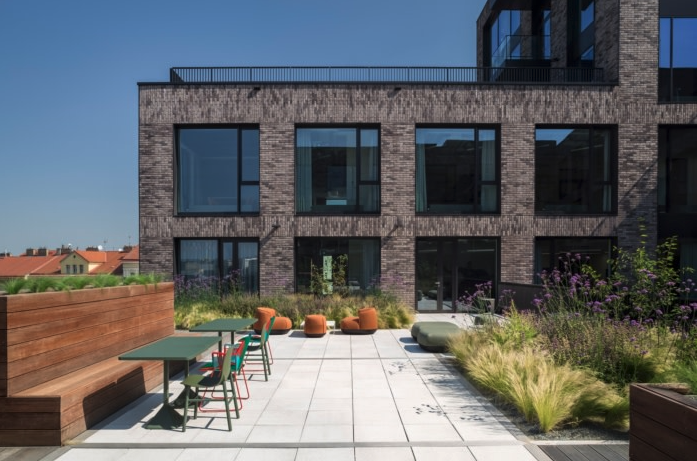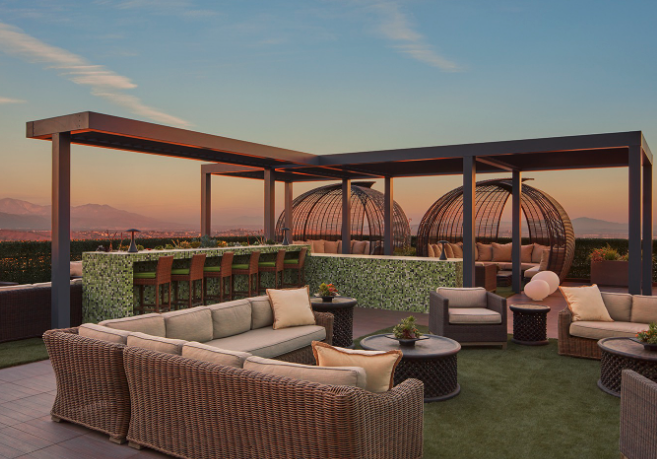Why Outdoor Workspaces Are On Your Employees’ Wish List


For much of the past decade, one of the most popular workplace design trends was finding ways to bring the outdoors inside.
Workspace designers would use elements that maximized sunlight and furniture made with natural materials, add hanging plants, and install living green walls. Now, in the wake of the COVID-19 pandemic, the strategy has shifted.
Rather than incorporating the outside environment into the inside of the workplace, employers are simply creating outdoor workspaces. The approach is different, but the goal is the same: embrace the biophilia hypothesis (which states that we have an innate tendency to seek connections with nature), and enjoy the benefits that come with it.
Here are a few reasons to consider outdoor workspaces and how you can incorporate them.
What are the benefits of outdoor workspaces?
In 2018, L.L. Bean partnered with workplace strategy expert Leigh Stringer to conduct a survey of 1,050 professionals aged 22-65 who worked primarily indoors.
The survey revealed that nearly 90% of employees prefer to spend more time in the open air during the workday. However, 75% said they spent little to no time working outside, and only half of the survey participants felt their supervisor would be supportive of them working in an outdoor area.
This is unfortunate, considering professionals believe there are substantial benefits to having the ability to work outside. Outdoor work environments have the potential to improve employees’ moods, lower their stress levels, and increase their happiness.
There are multiple studies that support these claims about the positive impact of being in the fresh air:
- A 2019 study published in Frontiers in Psychology found interactions with natural environments positively impacted cognitive performance, particularly when completing complex tasks.
- A 2018 review of 42 separate investigations confirmed exposure to natural environments improves working memory and cognitive flexibility.
- Research from Cornell University showed that spending as few as 10 minutes in a natural setting helped college students feel happier and less stressed, both physically and mentally.
- A 2019 article published in Science Advances explored how being outdoors can lead to increased happiness and well-being, as well as higher quality sleep, improved social skills, better manageability of tasks, and greater creativity.
This is barely scratching the surface of the available research on the topic.
All these benefits translate to increased productivity, better problem-solving, higher engagement, and a workforce that feels inspired, encouraged, and supported. In other words, it’s in the best interest of your company to consider adding outdoor office space if possible.
What are the elements of great outdoor workspaces?
Wireless technology
First and foremost, make sure you design outdoor spaces to support the use of laptops, mobile apps, and other technology.
You’ll need plenty of GFCI outlets and a strong Wi-Fi signal. If you want the outdoor rooms to be somewhere employees can host meetings, consider installing a TV or a wireless projector and screen to facilitate screen-sharing and presentations.
Finally, ensure any outdoor assets are properly protected from sun, wind, rain, snow, and heat and have plug-and-play functionality.
Multi-purpose outdoor furniture
Your outdoor workspace should have the type of furniture that is best suited for the type of work you expect employees will engage in.
For outdoor meetings and collaborative work, you’ll need larger tables that can seat five to six people. Lounge chairs with ottomans are perfect for employees who use the space for solo tasks.
All office furniture should be designed for outdoor use and easily cleaned and sanitized. It should also be lightweight and reconfigurable so it can quickly be moved as needed but also heavy enough to stay put on windy days.
Privacy and sound control
As with any indoor workspace, you have to take noise levels and privacy into consideration when designing your outdoor workspace.
Live plants can act as natural barriers and sound dampeners. Water features such as fountains and water walls can also help minimize noise while adding a soothing effect.
Another option is to install outdoor speakers, which can add ambiance to an open space while masking street noise.
Protection from the elements
Designing an outdoor workspace comes with the added challenge of protecting employees, equipment, and assets from the elements.
Canopies, sunshades, and umbrellas are an effective way to provide relief from the sun and cut down on screen glare. For warm days, fans and misters can make an outdoor workspace much more comfortable. (As an added bonus, fans can also help to minimize noise.) Heat lamps, fire pits, and outdoor fireplaces can keep employees warm in the winter.
If you are including outdoor workspaces as part of new construction, you can incorporate overhangs into the design for added shade and protection from rain.
Connection to the interior
While outdoor spaces are intended to offer a change of scenery, you should try to design the space so it simply feels like an outdoor version of your existing office design.
Walls in between the outdoor workspace and the interior of the building should be primarily glass or at least have large windows to prevent the space from feeling totally detached from the rest of the office.
If the workspace is on a balcony or terrace, try to have multiple entries and exits. And if the workspace is in a ground-level courtyard, use furniture and design elements that match your brand’s identity to maintain the connection to the main space.
What are examples of beautiful outdoor workspaces?
Lincoln Property Group (Washington, D.C.)
For their rooftop terrace, Lincoln Property Company wanted to create a space that was flexible enough to support both its early bird and night-owl employees. This outdoor workspace can function as a lunch spot, meeting space, individual work area, and after-work event venue with modular seating, pendant lighting, and plenty of power outlets.

Wellworth Coworking (Minneapolis)
The giant rooftop patio at the Wellworth Coworking offices in Minneapolis was designed to support individual work, impromptu conversations, casual meetings, and, most importantly, relaxation. It has couches, cafe seating, and sets of Adirondack chairs situated around fire pits. It also shares an entrance with the community coffee shop.

(Source)
Fortuna Entertainment Group (Prague)
Fortuna Entertainment Group in Prague took a simple, sustainable, and efficient approach to designing the interior and exterior of their workplace. Their outdoor terrace has several seating options for both collaborative and solo work along with a beautiful selection of plants and flowers and a breathtaking view of the city.

(Source)
Nixon Peabody (Los Angeles)
The goal of Nixon Peabody’s private outdoor terrace is to provide a cozy, relaxing atmosphere where employees can take a break from the hustle and bustle of the workday, enjoy some time to themselves, and come back inside feeling refreshed. Employees are also invited to use any of the comfortable couches or bar-height tables and stools for solo work or casual meetings while enjoying an incredible view of Los Angeles.

(Source)
How can you consider outdoor workspaces in your space planning?
Outdoor workspaces are an essential part of a post-COVID-19 workplace because they offer a new incentive for employees to come to the office, which is fundamental to building strong personal connections. They are also scientifically proven to support employee health and happiness.
If your office space includes a patio, terrace, or any area you could potentially convert into an outdoor workspace, make sure you’ve accounted for it in your floor plans. Be sure you have accurate measurements of the gross square footage and the total rentable square footage (your GSF minus any non-occupiable areas.)
Once you’ve updated your floor plans, convert them into digital models using our space management software. You may also need to use our Space-Right planning feature to ensure you set an appropriate physical distance between workspaces, especially in smaller areas.
Because your new outdoor workspaces will be in high demand, you may also want to make them reservable. Desk hoteling software makes it easy for employees to book outdoor spaces in advance so they can meet with their team or work quietly on a project in a more natural, comfortable setting.
With workplaces reopening and warmer weather on the horizon, it’s the perfect time to add outdoor workspaces to your office. Your employees will be delighted to have more options, and there’s a good chance they’ll be more productive, too.
For more ideas on how to improve your employee experience by rethinking office design, technology, and policies, download the latest Verdantix report.
